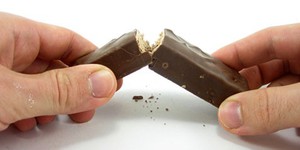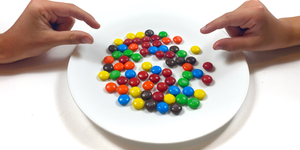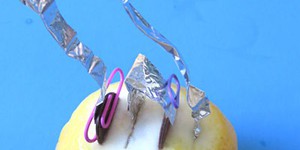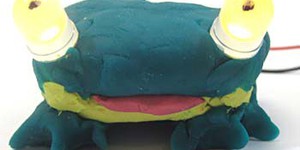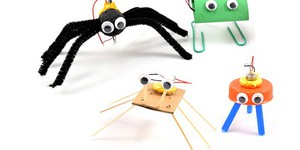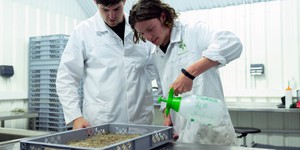Candy Lightning: A Flashy Activity
Summary

Introduction
Did you know that instances of miniature lightning can occur in your mouth when you bite on a hard candy? Would it not be fascinating if you could observe these light flashes? Life Savers® Wint O Green® mints might just be the tool we need to observe this science! Crush them, observe, and detect what makes the flashes visible. How many sparks can you see?
Materials
- Life Savers Mints- Wint O Green
- Sugar Free Life Savers Mints- Wint O Green
- Life Savers Mints- Spear O Mint® and/or Pep O Mint®
- Other hard candy (optional)
- Pliers
- Dark room
- Optional: mirror
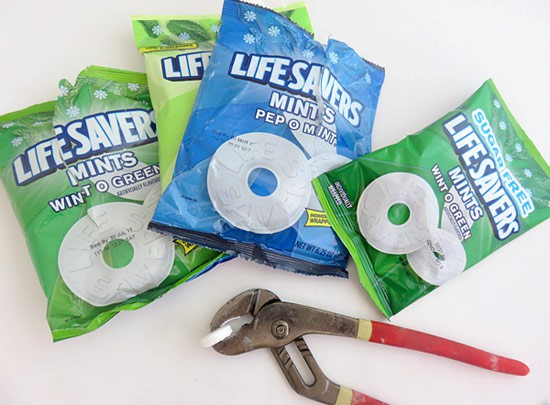 Image Credit: Sabine De Brabandere, Science Buddies / Science Buddies
Image Credit: Sabine De Brabandere, Science Buddies / Science Buddies
Prep Work
Instructions
- Note: The electrical discharges created in this activity are tiny and harmless. Although it is the same phenomenon, lightning in storms is created by huge discharges and is dangerous.
- Place one Life Savers mint between a pair of pliers and turn off the light. Wait a minute or two to let your eyes adjust to the dark, then watch the candy as you crush it.Did you see anything?
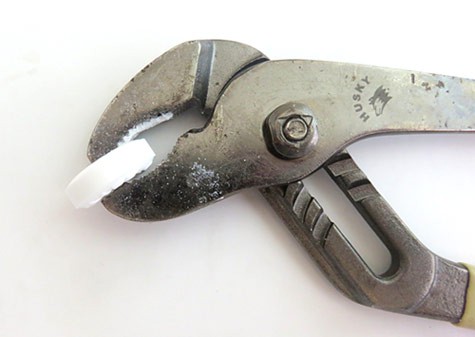 Image Credit: Sabine De Brabandere, Science Buddies / Science Buddies
Image Credit: Sabine De Brabandere, Science Buddies / Science Buddies
- Repeat with all other types of mints.Did you see anything happening as you crushed some types of Life Savers whereas it did not happen when you crushed other types?
- To confirm your findings, repeat the activity a few times.Does the same phenomenon happen each time with the same type(s) of Life Savers mint and not with others?
- You probably detected it for only one of the types of Life Savers you crushed. Can you find which combination of ingredients is responsible for the phenomenon? You will need some detective skills to find out!Where can you find the ingredients of each type of candy? In what way(s) are the ingredients of the mint that shows the phenomenon different?
- Investigate what exactly creates the flash. Take another Life Savers mint, the type that exhibited the phenomenon, and start exploring. We know the flash happens when we crush the candy with pliers.Does it also happen when you rub two broken pieces together or when you press just enough on the pliers to put the candy under pressure without breaking it?
- If you are wondering if it happens when you chew the candy, try it out. Chew this type of Life Savers mint in a dark room in front of a mirror. Open your mouth wide between chews.Can you see a flash?
Cleanup
What Happened?
Did you see a light flash when crushing the sugar-containing Life Savers Wint O Green mints, but not when crushing the other types of Life Savers mints? This is expected. You need hard crystalline sugar as well as the artificial flavoring substance in the Wint O Green type to create the flash.
Crushing hard crystalline sugar creates static electricity, which can lead to a mini discharge—a kind of miniature lightning. The discharge is usually accompanied by ultraviolet (UV) light, which is a type of light humans cannot see. A fluorescent substance—a substance that absorbs UV light and release it again as light humans can see—can make the light flash visible, and that is exactly what the artificial flavoring substance in the Wint O Green mint does.
Although lots of hard crystalline structures emit UV light when crushed, the crystals in the sugar substitute do not. Therefore, there was no UV flash to see when crushing the sugar free Wint O Green mints.
Digging Deeper
Lightning is a massive release of static electricity. It starts when icy raindrops rub against the air. This rubbing gives rise to static electricity, and sometimes the electricity can jump across an air gap. This is called a discharge, or spark. Within clouds or between the clouds and Earth, the discharge is huge; it heats the air to the extent that it glows with white light. That glowing white light is the lightning you see.
Miniature buildups of static electricity occur often. Maybe you remember your hair standing up after brushing it, or clothes clinging together when they come out of the dryer. In both examples, rubbing created static electricity. Crushing particular crystalline structures like hard sugar or salt also gives rise to static electricity.
Whenever there is static electricity, a release might happen. You might have felt or seen a discharge when touching a metal doorknob after walking across a carpeted floor. Although releases occur often, we hardly ever see a light flash. These miniature releases excite the air around it, which then typically releases ultraviolet (UV) light, a type of light humans cannot see. Note that many animals, like insects and birds, would observe this UV light flash because their eyes are sensitive to UV light—but human eyes are not.
It is only when there is a fluorescent substance around, which can absorb the UV light and reemit it as visible light, that we see a tiny light flash. This is exactly what happens when lightning occurs, and in this activity as well. When we crush Life Savers Wint O Green mints, the UV light created from crushing the hard crystalline sugar gets absorbed by the fluorescent substance and released again as light humans can observe. Voilá—there is your light flash!
Ask an Expert
For Further Exploration
- Investigate other candies containing hard crystalline sugar and the special ingredient. Can you create a flash with those as well?
- Try to create miniature lightning. Vigorously rub a piece of paper with wool for about a minute. Put a piece of metal (such as aluminum foil) in the center of the paper. Remove the paper and bring your finger close to the metal. Can you create a tiny spark?
Related Resources
Project Ideas
Activities
Lesson Plans
- 4-PS3-2. Make observations to provide evidence that energy can be transferred from place to place by sound, light, heat, and electric currents.
- 3-5-ETS1-2. Generate and compare multiple possible solutions to a problem based on how well each is likely to meet the criteria and constraints of the problem.
Links
- Blog Post: Valentine's Day Candy Science
- Blog Post: Valentine Candy Science





